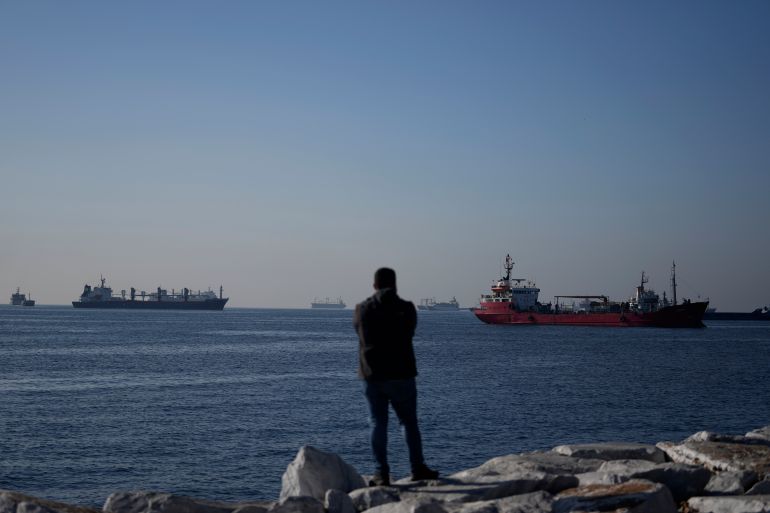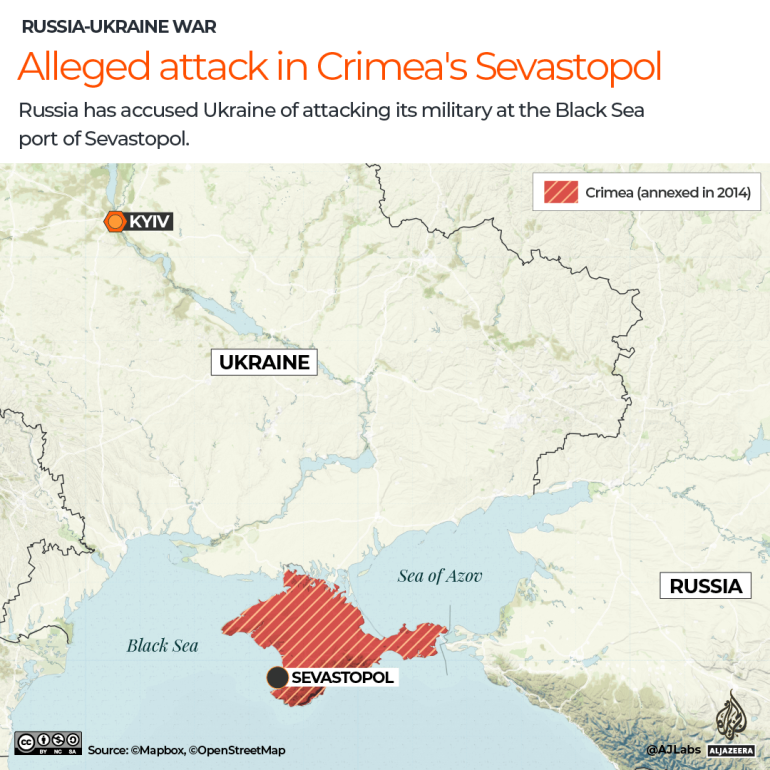Russia sparks global food crisis fears, again, as war grinds on
In the 36th week of Russia’s war in Ukraine, a grain export deal was threatened after an alleged attack in Crimea.

In the 36th week of war in Ukraine, Russia backed out of a United Nations-sponsored agreement guaranteeing the safe passage of grain ships through the Black Sea, only to rejoin it three days later.
Moscow’s withdrawal over the weekend renewed fears of a global food crisis – concerns that have not been completely quelled since it rejoined because its return came with conditions.
President Vladimir Putin said he reserved the right to back out again if Kyiv used the humanitarian corridor for attacks, the reason Russia gave for the initial pullout. The Kremlin has also warned that it has not yet decided whether to extend the grain deal, which expires in two weeks.
Officials in Moscow had said that grain ships may have acted as a cloak for an attack on its naval base on Saturday at Sevastopol on the Crimean Peninsula.
Keep reading
list of 4 itemsPutin wants the world to forget Ukraine
Arab League says Palestinian cause central, glosses over Israel
North Korea covertly shipping artillery shells to Russia, US says
On Wednesday, Russia said it had received written guarantees from Ukraine that the safe corridor would not be used for military purposes.
Ukraine is one of the largest grain exporters in the world, and the move momentarily threatened its export income as well as hunger in the Middle East and Africa. But Turkey and the UN, which are parties to the agreement known as the Black Sea Initiative, maintained the safe corridor during Russia’s brief withdrawal.
Drone attack
The attack on Sevastopol came before dawn on October 29. Ukraine released nighttime footage of what are called unmanned surface vehicles – essentially torpedoes embedded in boats – making their way towards Russian navy ships in or near the port of Sevastopol.
The footage of one of these naval drones shows it approaching a Grigorovich-class frigate, identified as the Admiral Makarov, before cutting out. It is not clear if the frigate was hit. The Russian defence ministry said the Makarov was undamaged and a minesweeper suffered minor damage. Other footage shows an aerial drone exploding in the port itself.
Russia said it had destroyed all nine of the aerial drones launched against Sevastopol and four of the seven naval drones.
Three of the naval drones made it into the bay before being destroyed, it said. Ukraine denied responsibility for the attack, but arms experts said the footage released online suggested that the naval drones were of a type used by Ukraine.
“The Black Sea Fleet has three Grigorovich-class frigates, all of which are capable of firing Kalibr cruise missiles,” the Institute for the Study of War said. “A Ukrainian decision to target a Kalibr-capable frigate at this time makes sense given the intensified Russian drone and missile strike campaign.”
Russia’s defence ministry said the next day that it had retrieved an aerial drone with its on-board memory intact and reconstructed its flight path from the Ukrainian coast near Odesa. The ministry said the drone flew along the safe corridor used by ships carrying Ukrainian grain before veering towards Sevastopol. It suggested the cargo ships could have been complicit.
“According to experts, this [starting point in the grain corridor zone in the Black Sea] may indicate a preliminary launch of the apparatus from aboard a civilian vessel chartered by Kyiv or patrons from the West to export agricultural products from the seaports of Ukraine,” the ministry said.
Such accusations are not new.
Putin said on October 8 that a bomb that damaged the Kerch Bridge, which connects Russia with Crimea, might have been carried out of Odesa on a grain truck. If that is proven, he said, he would withdraw Russia from the Black Sea Initiative.
That withdrawal was made less than a month later after the Sevastopol attack. Russia told the initiative’s UN coordinator in Istanbul that it could “not guarantee the safety of civilian ships.”
No ships sailed through the corridor the day after the attack.
Lithuanian foreign minister Gabrielius Landsbergis suggested Western government could protect the grain ships with military escorts, but this proved unnecessary.
The UN and Turkey scheduled 16 ships to sail on Monday, essentially calling Russia’s bluff. Putin reacted by saying he was only suspending Russian participation in the grain deal, not ending it.
US Secretary of State Antony Blinken called Russia’s withdrawal “a statement that people and families around the world should pay more for food or go hungry.”
Anatoly Antonov, Russia’s ambassador to Washington, said it was Kyiv that had acted recklessly.
“Everything has been reduced to false accusations of our country in the aggravation of the world food problem,” he said.
When the July 22 grain deal was signed, Ukrainian agriculture minister Mykola Solskyi estimated Ukraine had $10bn worth of grain ready to export and an additional $20bn of other agricultural products. So far, Ukraine has shipped 9.5 million tonnes of grain to world markets worth about $3bn.
Russia has had complaints about the grain deal, saying the UN did not honour a parallel agreement to help remove obstacles to the export of Russian grain and fertiliser to global markets. It also says promises to lift sanctions on Russian-owned ships carrying grain and fertiliser were broken.
Air bombardments
Moscow unleashed a barrage of drone attacks on Ukrainian infrastructure two days after the Sevastopol attack.
Ukrainian Prime Minister Denys Shmyal said 18 energy facilities were hit, resulting in power outages.
“Ten regions were hit by missiles and drones, where 18 facilities were damaged,” Shmyhal wrote on his Telegram channel. “Most of which were energy facilities. Hundreds of settlements in seven regions of Ukraine were de-energised.”
Kiyv Mayor Vitali Klitschko said parts of the city were without water and energy following air strikes.
Russian state news agency Tass reported explosions near three hydroelectric power stations – Dneprovskaya, Dniester and Kremenchug – all along the Dnipro River.
Ukraine’s general staff said their forces had shot down 45 out of 60 missiles fired into Ukraine on Monday.
The strikes carried on the next day. Russia fired four S-300 missiles into the city of Mykolaiv, causing one death and damage to schools and homes.
Grinding ground war
Meanwhile, Russian forces were reported to have edged closer to Bakhmut on Ukraine’s eastern front.
They have been bombarding this key logistics centre for weeks.
Its capture would disrupt Ukrainian military supplies and make it easier for Russia to march on Slovyansk and Kramatorsk, cities at the heart of Donetsk province.
The Institute for the Study of War said Russian troops had already falsely claimed to have captured several towns near Bakhmut.
“Russian forces are likely falsifying claims of advances in the Bakhmut area to portray themselves as making gains in at least one sector amid continuing losses in northeast and southern Ukraine,” the institute said.
Yevgeny Prigozhin – founder of the Wagner Group, which is said to be spearheading the Bakhmut offensive – effectively admitted the deadlock when he said on October 23 that the front was moving forward by 100 to 200 metres (330 to 660 feet) a day, which he called a success.
“In the conditions of modern warfare, these are effective and confident steps forward,” Prigozhin said.
Chechnya-based Grozny TV reported that Colonel Alexander Lapin was dismissed as commander of Russia’s eastern forces. If confirmed, it would be another indication of the Russian command’s unhappiness with the Bakhmut front.
Russian occupation forces in the southern region of Kherson said they had completed an evacuation of 60,000 civilians from the west bank of the Dnipro River in anticipation of a new Ukrainian counteroffensive. Ukraine’s general staff said Russian forces were preparing to withdraw their artillery as well.
Kirill Stremousov, deputy occupation governor of the region, said the Ukrainian army “continue to accumulate their forces to carry out a counteroffensive on Kherson.”
Major General Kyrylo Budanov, chief of the Military Intelligence of Ukraine, said Ukrainian troops were fighting every day to try to encircle Kherson city but were up against some of Russia’s most capable soldiers – special forces, marines and airborne troops.
He estimated that Kherson could fall as soon as the end of the month – a month earlier than his previous public estimate.
Budanov also said he expected a Ukrainian counteroffensive in Crimea next year.
The Ukrainian counteroffensive launched on August 29 has recaptured 1,170sq km (450sq miles) of territory in Kherson, according to Kyiv.
All the while, Russia has tried to address manpower shortages with a mobilisation the Kremlin said has put 41,000 men in the field and another 260,000 in training.
But The Associated Press news agency reported that Russia is also recruiting Afghan commandos trained by the US Navy Seals and Blue Berets.
Three former Afghan generals told the AP that Moscow was drawing the men, who are living in exile in Iran, with salaries of $1,500 a month and a promise of a safe haven.